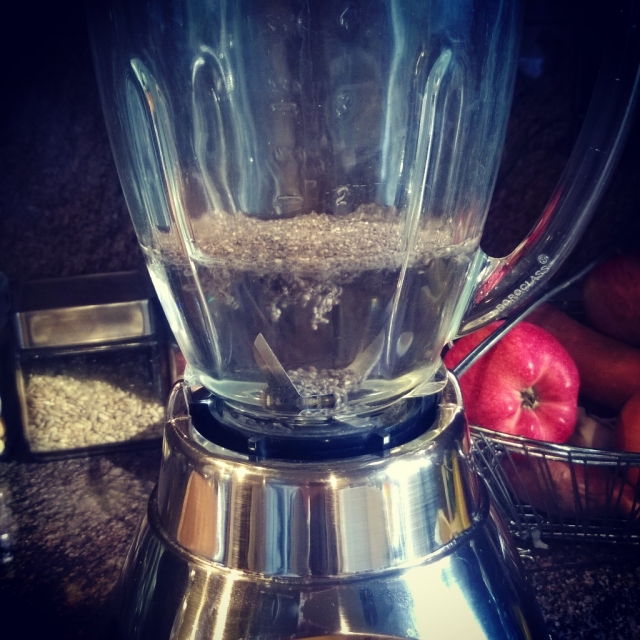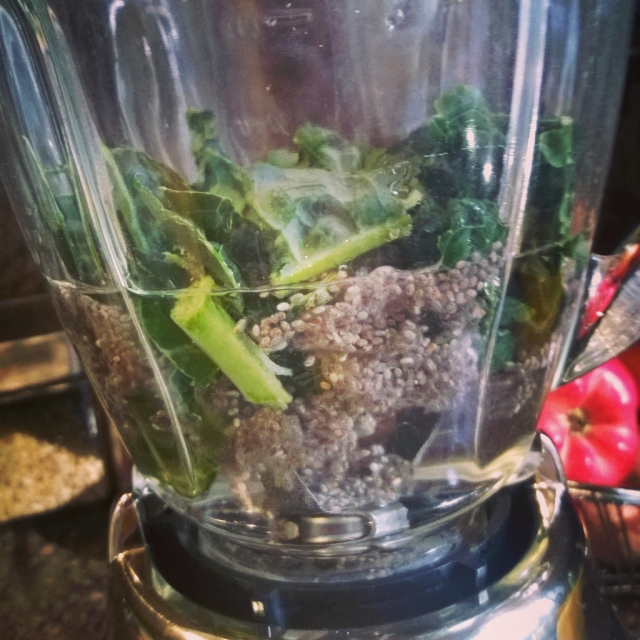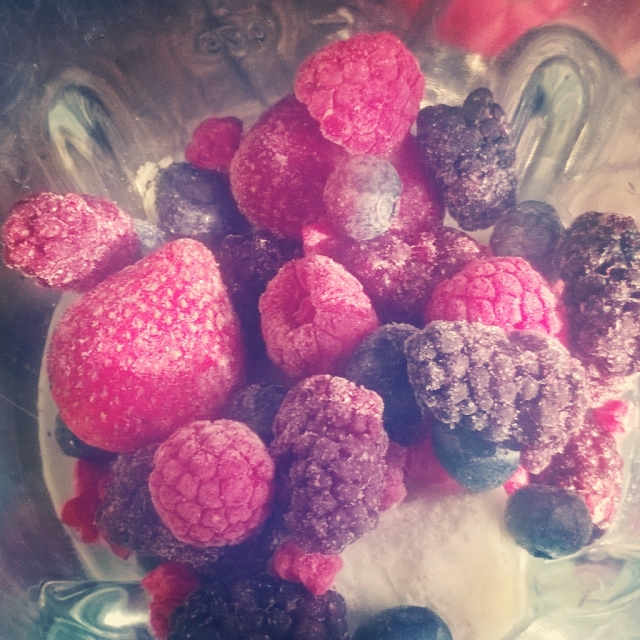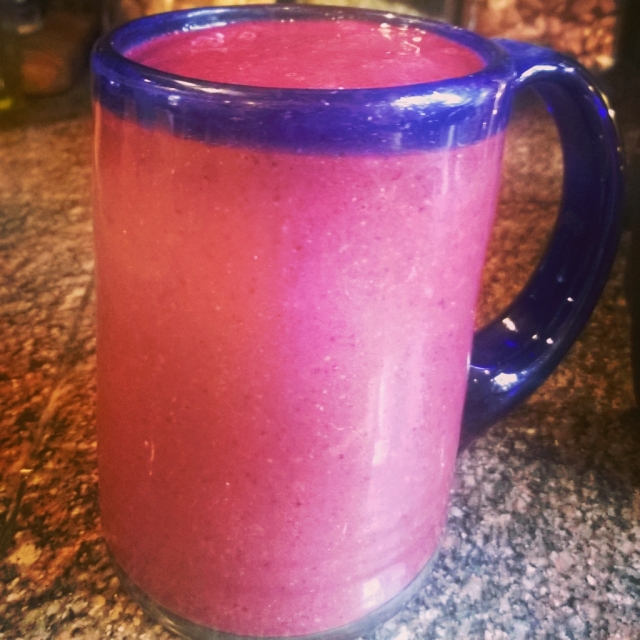When I first started really trying to kick food intolerances, I began making protein smoothies for breakfast because my naturopath and my own research into healing food intolerances made it clear that protein is vital. That was years ago but I still do it every single day because I have found my blood sugar stays stable with a big dose of protein to start my metabolism in the morning. It’s an excellent way to take herbs too, powdered or tinctured, and I like to sneak in as many greens as possible. Now I’m making two smoothies in the morning in an effort to get more protein into my youngest before he goes off to school because he says he gets hungry before lunchtime. I sneak greens into there as well, and some herbs too. The first recipe is what I make for myself.
Berry Green Protein Smoothie
1 T. of chia seeds
1 teaspoon herbal adaptogen mix and 1/2 t. digest mix (optional but recommended)
1 leaf of kale torn into pieces or a handful of spinach
1 scoop Vanilla Protein Powder by Vega
1/2 of a frozen banana
around 3/4 cups frozen berries
First I fill the blender with 1 cup of cold water (more or less) and add 1 T. of chia seeds and let them soak for about 10 minutes. 
Next I add my 1 teaspoon herbal adaptogen mix and 1/2 t. digest mix,
then about 1 leaf of kale or a handful of spinach if I am out of kale.
Next the protein powder goes in, along with about half a frozen banana (I freeze them myself) and about 1 C of frozen mixed berries. I use Vanilla Protein Powder by Vega because my naturopath recommended it when our family was avoiding a whole slew of foods due to intolerances. It is a vegan protein powder that is exceptionally tasty and clean, with greens built in.
After that I warn anyone nearby that I’m starting the blender because it’s loud. Feel free to replace the water and seeds with milk of choice in either of these recipes.
The following smoothie recipe is more kid friendly because of the vanilla yogurt, and I put in less greens and herbs. The yogurt makes this smoothie fluffier and more whipped. My youngest still gives me a little bit of a hard time about it and drinks less of a serving than I would like, but the rest of the family happily drinks all of theirs so it’s worth it.
Strawberry Vanilla Smoothie
1 tablespoon ground flax seeds
1/2 teaspoon adaptogen mix (optional)
1/2 teaspoon digest mix (optional but highly recommended)
Small handful of spinach or kale (optional)
1/2 cup Vanilla Siggi’s Yogurt
one scoop of Vega’s Vanilla Protein Powder
1 frozen banana
1.5 cups frozen strawberries
1/4 teaspoon vanilla extract (optional)
Fill the blender with 1 cup or so of water and 1 tablespoon ground flax seeds. Let the seeds soak for about 10 minutes. Add 1/2 teaspoon adaptogen mix and 1/2 teaspoon digest mix. Next goes in a small handful of spinach (as long as no one is looking!) and 1/2 cup Vanilla Siggi’s Yogurt which is full of protein and not too much sugar. Add a scoop of Vega’s Vanilla Protein Powder, a frozen banana, and about 1.5 cups of frozen strawberries and 1/4 teaspoon vanilla extract if you want. Blends up to be enough for three servings, one of which is rather small though.
![WP_20181010_06_37_53_Pro[1]](https://i0.wp.com/botanicalalchemyandapothecary.com/wp-content/uploads/2018/10/WP_20181010_06_37_53_Pro1-1728416718-1539179666786.jpg?resize=828.75%2C765&ssl=1)
My youngest also insists that the smoothie tastes *much* better when sucked through a straw. We have a few plastic straws left in our house from bygone years, but now I wouldn’t buy them even if I could find them. I went looking for eco-friendly alternatives and only found metal ones, which will hopefully work for his very discerning taste buds, but I found these other alternatives in an article by Delicious Living which I want to try out, especially the 10 inch smoothie straw. Here are the eco-friendly straws from the article:
EcoStraw 10-inch Smoothie Straw:
Hewn in the United States, this Pyrex, dishwasher-safe straw is wider than standard straws to accommodate viscous liquids like smoothies.
Compostable in municipal facilities, each beautiful, celebratory 7.75-inch straw comes from renewable, sustainably harvested paper. Plus, they’re made in the U.S.A.
CocoStraw Stainless Steel Drinking Straws:
Made with food-grade stainless steel, these unbreakable straws are perfect replacements for plastic varieties. Each four-pack comes with a cleaner, too.
Seattle is one of the first cities to ban plastic straws and utensils, but hopefully these disposable items will be nothing but a thing of the past soon. Might as well get used to the more eco-friendly alternatives now.
Please share with anyone who might be looking for a new smoothie recipe or plastic straw alternatives, and please subscribe for weekly wellness blog posts.

![0D89230D-57FF-4214-8175-C6905F1ACCDE[1] 0D89230D-57FF-4214-8175-C6905F1ACCDE[1]](https://i0.wp.com/botanicalalchemyandapothecary.com/wp-content/uploads/2018/10/0D89230D-57FF-4214-8175-C6905F1ACCDE1.jpg?w=410&h=410&crop=1&ssl=1)
![704D5D15-DFB4-4CDC-AF0F-997E771091B3[2] 704D5D15-DFB4-4CDC-AF0F-997E771091B3[2]](https://i0.wp.com/botanicalalchemyandapothecary.com/wp-content/uploads/2018/10/704D5D15-DFB4-4CDC-AF0F-997E771091B32.jpg?w=410&h=410&crop=1&ssl=1)







![71BF7D5F-E702-47DF-BAF7-E420E2EE07C8[1] 71BF7D5F-E702-47DF-BAF7-E420E2EE07C8[1]](https://i0.wp.com/botanicalalchemyandapothecary.com/wp-content/uploads/2018/03/71BF7D5F-E702-47DF-BAF7-E420E2EE07C81.jpg?w=417&h=418&ssl=1)
![111B96D2-33C6-4237-84D2-3C92F483CF67[1] 111B96D2-33C6-4237-84D2-3C92F483CF67[1]](https://i0.wp.com/botanicalalchemyandapothecary.com/wp-content/uploads/2018/03/111B96D2-33C6-4237-84D2-3C92F483CF671.jpg?w=403&h=418&ssl=1)
![1CC8D5B1-443D-472F-90ED-CB46BEA96694[1]](https://i0.wp.com/botanicalalchemyandapothecary.com/wp-content/uploads/2018/03/1CC8D5B1-443D-472F-90ED-CB46BEA966941.jpg?resize=828.75%2C829&ssl=1)

![873EEE91-8D10-46B6-BC28-195E2087D2D5[1]](https://i0.wp.com/botanicalalchemyandapothecary.com/wp-content/uploads/2018/03/873EEE91-8D10-46B6-BC28-195E2087D2D51.jpg?resize=240%2C300&ssl=1)
![B9E879BB-BC76-4629-A996-20C6FBC5357E[1]](https://i0.wp.com/botanicalalchemyandapothecary.com/wp-content/uploads/2018/03/B9E879BB-BC76-4629-A996-20C6FBC5357E1.jpg?resize=828.75%2C829&ssl=1)
![60CC06EA-3A85-42CD-B760-E6E47C36BC39[1]](https://i0.wp.com/botanicalalchemyandapothecary.com/wp-content/uploads/2018/03/60CC06EA-3A85-42CD-B760-E6E47C36BC391-1024x1024.jpg?resize=828.75%2C829&ssl=1) Once your ball is a good size, take a large-eyed needle or crochet hook to bury the end of the yarn into the ball. You can completely bury it, or cut off the end of the yarn after a few tucks if you prefer. Here’s Lani showing how it’s done:
Once your ball is a good size, take a large-eyed needle or crochet hook to bury the end of the yarn into the ball. You can completely bury it, or cut off the end of the yarn after a few tucks if you prefer. Here’s Lani showing how it’s done:![WP_20180308_11_45_39_Pro_(2)[1]](https://i0.wp.com/botanicalalchemyandapothecary.com/wp-content/uploads/2018/03/WP_20180308_11_45_39_Pro_21.jpg?resize=828.75%2C568&ssl=1)
![3645E236-F1EC-43CE-A87B-E0E7CC5B3204[1]](https://i0.wp.com/botanicalalchemyandapothecary.com/wp-content/uploads/2018/03/3645E236-F1EC-43CE-A87B-E0E7CC5B32041-300x269.jpg?resize=300%2C269&ssl=1)




